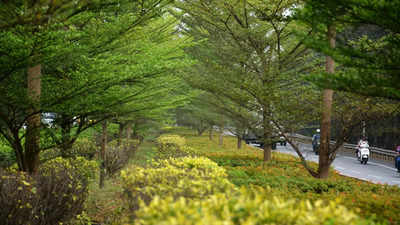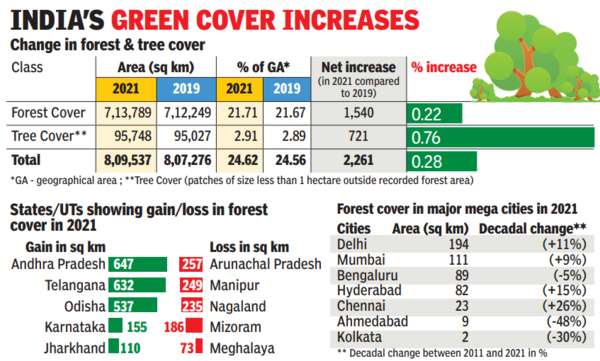- News
- India News
- India’s green cover rises, touches nearly one-fourth of geographical area: Report
Trending
This story is from January 14, 2022
India’s green cover rises, touches nearly one-fourth of geographical area: Report
India’s green cover has touched nearly one-fourth of its geographical area with "forests" and "trees outside recorded forest areas" put together recording an increase of 2,261 sq km (0.3%) in 2021 compared to the previous assessment in 2019, shows the latest India State of Forest Report (ISFR 2021) released on Thursday.

NEW DELHI: India’s green cover has touched nearly one-fourth of its geographical area with "forests" and "trees outside recorded forest areas" put together recording an increase of 2,261 sq km (0.3%) in 2021 compared to the previous assessment in 2019, shows the latest India State of Forest Report (ISFR 2021) released on Thursday.
The total green (forests and trees) cover has now reached 8,09,537 sq km (24.6% of geographical area), which includes 7,13,789 sq km of forest cover — 21.7% of the area.Overall, forest cover has recorded an increase of 1,540 sq km (0.2%) while tree cover increased by 721 sq km (0.8%) in the past two years.
Releasing ISFR 2021, environment minister Bhupender Yadav emphasised on the government's priority to focus not just on increasing/conserving the forest cover quantitatively but also enriching it qualitatively, and noted that 17 states/UT’s have above 33% of the geographical area under forest cover.

ISFR 2021 shows that five states/UTs — Lakshadweep, Mizoram, Andaman & Nicobar Islands, Arunachal Pradesh and Meghalaya — have more than 75% forest cover while 12 states/UTs — Manipur, Nagaland, Tripura, Goa, Kerala, Sikkim, Uttarakhand, Chhattisgarh, Dadra & Nagar Haveli and Daman & Diu, Assam, Odisha — have forest cover between 33% and 75%.
Overall, the increase in forest cover has, however, been mainly observed in the "open forest" category followed by "very dense forest". Forest cover includes all land more than one hectare in area with a tree canopy density of more than 10%. Land with a tree canopy density of 70% and above is classified as "very dense forest (VDF)" while land with a canopy density of 10% and more but less than 40% is classified as "open forest (OF)".
Similarly, land with a canopy density of 40% and more but less than 70% is put under the "moderately dense forest (MDF)" category, which, in fact, reported a decline of 1,582 sq km in 2021 compared to 2019. In addition to the three density classes, scrub areas (forest lands with a canopy density of less than 10%) have also been classified and mapped. But scrub areas are not part of the forest cover.
The top three states showing an increase in forest cover are Andhra Pradesh (647 sq km), Telangana (632 sq km) and Odisha (537 sq km). Area-wise, Madhya Pradesh has the largest forest cover in the country followed by Arunachal Pradesh, Chhattisgarh, Odisha and Maharashtra. In terms of forest cover as percentage of total geographical area, the top five states are Mizoram (84.5%), Arunachal Pradesh (79.3%), Meghalaya (76%), Manipur (74.3%) and Nagaland (73.9%).
The report provides information on forest cover, tree cover, mangrove cover, growing stock, carbon stock in India’s forests, forest fire monitoring, above-ground estimates of biomass using satellite data and climate change hotspots in Indian forests. The forest and tree cover areas have been derived from complete wall-to-wall mapping of the country’s forest cover using remote sensing techniques, sample plot-based national forest inventory and special studies carried out at the national level.
The Forest Survey of India, which prepared the report, claimed that the satellite data interpretation is followed by rigorous ground truthing. "Information from other collateral sources is also used to improve the accuracy of the interpreted image. The accuracy level achieved in the current assessment is significantly high," said the environment ministry.
It claimed that the accuracy of forest cover classification has been assessed at 92.9%. "The accuracy of classification between forest and non-forest classes has been assessed 95.8% against internationally accepted accuracy of classification of more than 85%," said the ministry.
The biennial report has also for the first time included a special chapter on forest cover assessment in tiger reserves, tiger corridor areas, lion conservation areas and in seven major cities — Delhi, Mumbai, Bengaluru, Hyderabad, Ahmedabad, Chennai and Kolkata. It is seen that Delhi has the largest forest cover, followed by Mumbai and Bengaluru.
The latest assessment also shows an increase of 17 sq km in total mangrove cover (4,992 sq km in 2021) in the country as compared to the previous assessment. The top three states showing mangrove cover increase are Odisha (8 sq km), Maharashtra (4 sq km) and Karnataka (3 sq km).
The total green (forests and trees) cover has now reached 8,09,537 sq km (24.6% of geographical area), which includes 7,13,789 sq km of forest cover — 21.7% of the area.Overall, forest cover has recorded an increase of 1,540 sq km (0.2%) while tree cover increased by 721 sq km (0.8%) in the past two years.
Releasing ISFR 2021, environment minister Bhupender Yadav emphasised on the government's priority to focus not just on increasing/conserving the forest cover quantitatively but also enriching it qualitatively, and noted that 17 states/UT’s have above 33% of the geographical area under forest cover.

Yadav also underlined India's commitment to increase green cover, and reminded what Prime Minister Narendra Modi had promised at the UN climate conference (COP26) in Glasgow (UK) in November last year when he appealed to world leaders to focus on LIFE (Lifestyle for Environment) as a joint global campaign for a sustainable future.
ISFR 2021 shows that five states/UTs — Lakshadweep, Mizoram, Andaman & Nicobar Islands, Arunachal Pradesh and Meghalaya — have more than 75% forest cover while 12 states/UTs — Manipur, Nagaland, Tripura, Goa, Kerala, Sikkim, Uttarakhand, Chhattisgarh, Dadra & Nagar Haveli and Daman & Diu, Assam, Odisha — have forest cover between 33% and 75%.
Overall, the increase in forest cover has, however, been mainly observed in the "open forest" category followed by "very dense forest". Forest cover includes all land more than one hectare in area with a tree canopy density of more than 10%. Land with a tree canopy density of 70% and above is classified as "very dense forest (VDF)" while land with a canopy density of 10% and more but less than 40% is classified as "open forest (OF)".
Similarly, land with a canopy density of 40% and more but less than 70% is put under the "moderately dense forest (MDF)" category, which, in fact, reported a decline of 1,582 sq km in 2021 compared to 2019. In addition to the three density classes, scrub areas (forest lands with a canopy density of less than 10%) have also been classified and mapped. But scrub areas are not part of the forest cover.
The top three states showing an increase in forest cover are Andhra Pradesh (647 sq km), Telangana (632 sq km) and Odisha (537 sq km). Area-wise, Madhya Pradesh has the largest forest cover in the country followed by Arunachal Pradesh, Chhattisgarh, Odisha and Maharashtra. In terms of forest cover as percentage of total geographical area, the top five states are Mizoram (84.5%), Arunachal Pradesh (79.3%), Meghalaya (76%), Manipur (74.3%) and Nagaland (73.9%).
The report provides information on forest cover, tree cover, mangrove cover, growing stock, carbon stock in India’s forests, forest fire monitoring, above-ground estimates of biomass using satellite data and climate change hotspots in Indian forests. The forest and tree cover areas have been derived from complete wall-to-wall mapping of the country’s forest cover using remote sensing techniques, sample plot-based national forest inventory and special studies carried out at the national level.
The Forest Survey of India, which prepared the report, claimed that the satellite data interpretation is followed by rigorous ground truthing. "Information from other collateral sources is also used to improve the accuracy of the interpreted image. The accuracy level achieved in the current assessment is significantly high," said the environment ministry.
It claimed that the accuracy of forest cover classification has been assessed at 92.9%. "The accuracy of classification between forest and non-forest classes has been assessed 95.8% against internationally accepted accuracy of classification of more than 85%," said the ministry.
The biennial report has also for the first time included a special chapter on forest cover assessment in tiger reserves, tiger corridor areas, lion conservation areas and in seven major cities — Delhi, Mumbai, Bengaluru, Hyderabad, Ahmedabad, Chennai and Kolkata. It is seen that Delhi has the largest forest cover, followed by Mumbai and Bengaluru.
The latest assessment also shows an increase of 17 sq km in total mangrove cover (4,992 sq km in 2021) in the country as compared to the previous assessment. The top three states showing mangrove cover increase are Odisha (8 sq km), Maharashtra (4 sq km) and Karnataka (3 sq km).
End of Article
FOLLOW US ON SOCIAL MEDIA










